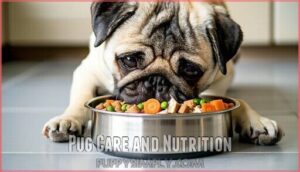This site is supported by our readers. We may earn a commission, at no cost to you, if you purchase through links.
 Your pug’s wrinkled face and snorty breathing might be adorable, but these same features can shave years off their life. Most pugs live between 12 and 15 years, though some make it to 17 with the right care.
Your pug’s wrinkled face and snorty breathing might be adorable, but these same features can shave years off their life. Most pugs live between 12 and 15 years, though some make it to 17 with the right care.
The difference between a pug who barely reaches their teens and one who thrives well past 15 often comes down to choices you make every single day—from the food bowl you fill to how you approach those hot summer walks.
Their flat faces, compact bodies, and love of food create a perfect storm of health challenges that need your attention early. Understanding what affects your pug’s lifespan gives you the power to help them beat the odds and spend more quality years by your side.
Table Of Contents
- Key Takeaways
- Pug Life Expectancy
- Pug Health Issues
- Pug Care and Nutrition
- Pug Life Stages
- Maximizing Pug Lifespan
- Responsible Pug Ownership
- Frequently Asked Questions (FAQs)
- What is the expected life expectancy of a pug?
- What is the average life span of a pug?
- What is the lifespan of a pug?
- What is the average lifespan of a pug/boxer mix?
- What is the main cause of death in Pugs?
- Is 7 old for a Pug?
- Can a Pug live 20 years?
- At what age do Pugs start having health problems?
- What is the leading cause of death in Pugs?
- Can Pugs live up to 20 years?
- Conclusion
Key Takeaways
- Pugs typically live 12-15 years, but daily choices about weight management, temperature control, and preventive care often determine whether your dog reaches the lower or upper end of that range—or even surpasses it.
- Obesity is the biggest controllable risk factor for pugs, potentially cutting two years off their lifespan, while their flat faces create breathing challenges that make heat management and exercise moderation critical for survival.
- Neurological disorders (especially encephalitis) are the leading cause of death in pugs at 27.4%, followed by respiratory failure and cardiac disease, with most health problems rooted in their genetic makeup and breeding history.
- Regular veterinary checkups every six months, daily wrinkle cleaning to prevent infections, and measured portions at mealtimes form the foundation of preventive care that gives pugs their best shot at reaching 15+ years.
Pug Life Expectancy
If you’re thinking about bringing a pug into your life, you’re probably wondering how long you’ll get to enjoy their company. The good news is that pugs usually live 12 to 15 years, though with the right care, some have been known to celebrate even more birthdays.
Let’s look at what influences how long your pug will be by your side.
Average Lifespan of Pugs
Most pugs live 12-15 years, though some outstanding pups reach their late teens or beyond. Your pug’s lifespan depends on genetics, care, and a bit of luck. Females often outlive males by several months, and smaller breeds like pugs generally outlast their larger cousins. Neurological disorders are a leading cause of death for pugs.
Here’s what affects pug lifespan averages:
- Typical range: 12-15 years for healthy pugs
- Gender differences: Females often live slightly longer
- Breed comparisons: Pugs outlive large breeds but trail toy breeds
- Record holders: The oldest pug reached an astonishing 27 years
- Age equivalents: Your 6-year-old pug equals a 40-year-old human
Understanding these pug breed longevity factors helps you extend your companion’s golden years.
Factors Affecting Pug Lifespan
Your pug’s longevity depends on several interconnected factors, each playing a distinct role in determining whether your companion reaches 12 or 15+ years. Genetic predisposition carries the most weight—some pugs inherit brachycephalic obstructive airway syndrome, which accounts for 8.2% of deaths, while neurological disorders cause 27.4% of fatalities.
Diet quality dramatically affects pug lifespan, with obesity being the breed’s top risk factor and potentially cutting two years off your dog’s life. Exercise balance is tricky for pugs; they need movement to stay lean but can’t endure marathon runs like other breeds. Indoor living protects them from heat stroke—responsible for 6.3% of pug deaths—since their compromised airways can’t regulate temperature well.
Preventative care through biannual vet visits catches problems early, and neutering extends median lifespan from 8 to 11 years. Pugs usually live for about 13 to 15 years, making regular check-ups essential.
Genetics and Breeding History
The blueprint for your pug’s health was written long before you brought them home—it’s locked in their DNA and shaped by generations of breeding choices. Genetic predisposition determines whether your pug inherits conditions like Pug Dog Encephalitis (PDE), which affects 15% of the breed. Pug breeding and genetics have concentrated both positive and negative traits through centuries of selective breeding.
Breeding ethics matter immensely. Responsible breeders use genetic testing to screen for inherited disorders, while puppy mills prioritize profit over pug genetics and health. Your pug’s lineage impact shows up in everything from breathing ability to disease resistance.
Five critical genetic factors affecting pug breed family history:
- PDE gene variants – Fatal brain inflammation strikes young pugs
- Inbreeding coefficients – Exceed 35% in some bloodlines
- Brachycephalic traits – Flat-face genetics cause lifelong complications
- Limited diversity – Small founder populations concentrate defects
- Hip dysplasia markers – Inherited joint problems reduce mobility
Choosing pugs from health-tested parents greatly improves your dog’s odds of a longer, healthier life.
Pug Health Issues
Pugs are lovable companions, but their unique build comes with specific health challenges. Understanding these common issues helps you catch problems early and keep your pug comfortable throughout their life.
Let’s look at the main health concerns every pug owner should know about.
Brachycephalic Syndrome
When your pug snorts through playtime or snores like a freight train, it’s not just quirky—it’s brachycephalic syndrome at work. This respiratory condition affects over half of pugs with narrowed nostrils and elongated soft palates blocking their airways.
You’ll notice exercise intolerance, noisy breathing, and dangerous heat sensitivity as clinical signs of BOAS. While surgical options like nostril widening improve breathing in 70-80% of cases, prevention focuses on weight management and avoiding overheating.
Sadly, respiratory issues from brachycephalic airway syndrome can shorten your pug’s life to just 8.6 years compared to 12.7 in other breeds.
Obesity and Weight Management
With obesity affecting pugs nearly three times more than other breeds, you’re fighting an uphill battle that can steal two precious years from your dog’s life. Breed predisposition makes weight management critical from day one. Here’s your action plan:
- Use a kitchen scale for precise calorie control—eyeballing portions doesn’t work
- Keep treats under 10% of daily intake to meet dietary needs without excess
- Build exercise routines with short, gentle walks that avoid joint stress
- Schedule monthly weigh-ins to catch problems early
Your pug diet should feature high-quality protein and measured portions. Exercise plans don’t need to be intense—consistency matters more than duration. A balanced diet paired with regular movement protects joints while burning calories. Remember, maintaining a healthy weight isn’t just about appearance—it’s directly linked to respiratory function and longevity in this breed.
Eye Problems and Vision Care
Behind those soulful, bulging eyes lies one of your pug’s biggest health vulnerabilities. Their prominent eye structure creates a perfect storm for corneal ulcers from minor scratches, plus breed-specific issues like dry eye and cherry eye. As your pug ages, progressive atrophy and cataracts become real concerns, potentially leading to vision loss.
| Condition | Warning Signs | Action Steps |
|---|---|---|
| Corneal Ulcers | Squinting, discharge, redness | Emergency vet visit within 24 hours |
| Dry Eye | Thick mucus, frequent blinking | Daily artificial tears as prescribed |
| Cherry Eye | Red mass in corner of eye | Schedule surgical correction |
| Cataracts | Cloudy lens, bumping into objects | Discuss cataract surgery options |
| Progressive Atrophy | Night blindness, dilated pupils | Regular monitoring, no current cure |
Clean around your pug’s eyes daily with a damp cloth and watch for excessive tearing or cloudiness. Keep your dog away from rough surfaces that could scratch those delicate eyes. Regular vet checkups catch pug eye problems early when treatment works best.
Skin Infections and Allergies
Your pug’s wrinkled face needs daily attention, or those charming folds become perfect hideouts for yeast and bacteria. Pugs’ breed predisposition makes skin infections and allergies common pug health issues that need preventative measures. Here’s how to protect your companion:
- Wrinkle hygiene: Clean facial folds daily with a soft, damp cloth, then dry completely to prevent moisture buildup.
- Allergen identification: Watch for excessive scratching, red patches, or ear infections that signal food or environmental allergies.
- Regular grooming: Bathe your pug monthly with gentle shampoo and inspect skin for hot spots or irritation.
- Treatment options: Work with your vet on medicated shampoos, antibiotics, or allergy testing when problems arise.
Daily care beats dealing with infections later.
Pug Care and Nutrition
What you feed your pug and how you care for them day-to-day makes a real difference in how long they’ll be by your side. Getting the basics right isn’t complicated, but it does require some attention to their unique needs.
Let’s look at the key areas where your daily choices can help your pug live their healthiest, longest life.
Diet and Nutrition for Pug Dogs
Think of feeding your pug like fueling a high-performance sports car—you wouldn’t dump just anything into the tank and expect peak performance. Your pug’s diet quality directly shapes their health and longevity.
Pug nutrition guidelines emphasize balanced dog nutrition with real meat as the primary ingredient, whether you’re choosing kibble vs. raw or exploring homemade diets. A healthy diet requires strict portion control—measure every meal to prevent the obesity that shortens lives by up to two years.
Here’s what smart Pug diet and nutrition looks like:
- Feed measured portions twice daily based on your pug’s weight and activity level
- Choose high-quality kibble that meets AAFCO standards for complete nutrition
- Monitor hydration needs closely since brachycephalic breeds overheat easily
- Discuss supplementation with your vet before adding anything to their bowl
Homemade diets need veterinary guidance to guarantee proper nutritional balance.
Exercise and Physical Activity for Pugs
Most pugs love a good stroll, but their flat faces mean exercise is a balancing act between keeping them fit and keeping them safe. Aim for two 15-20 minute walks daily when temperatures stay below 75°F. Their breathing problems make overexertion dangerous—watch for excessive panting, blue-tinged gums, or stumbling. Gentle activity levels protect joint health while preventing obesity.
| Safe Exercises | Overexertion Signs |
|---|---|
| Short morning/evening walks | Heavy panting that doesn’t stop |
| Indoor fetch sessions | Blue or pale gums |
| Puzzle toys for mental stimulation | Wobbling or collapsing |
| Swimming (supervised, cool water) | Excessive drooling |
| Slow-paced play with other dogs | Refusing to move |
Skip outdoor physical activity during heat or humidity—your pug’s breathing system can’t manage it.
Grooming and Hygiene for Pugs
Those adorable facial folds might steal hearts, but without proper care, they can become hotspots for infections that threaten your pug’s health. Daily wrinkle cleaning prevents bacteria buildup that leads to painful skin infections. Use soft, damp cloths or pet-safe wipes between each fold, then dry thoroughly—moisture is the enemy.
Don’t overlook those facial creases—untreated skin infections can seriously impact your pug’s quality of life. Regular grooming isn’t vanity; it’s preventive healthcare that keeps your pug comfortable throughout their 12-15 year lifespan.
Your grooming routine should include:
- Wrinkle cleaning daily with gentle wipes, drying each fold completely
- Dental hygiene through daily brushing to prevent gum disease that affects heart health
- Nail trimming every 2-3 weeks to avoid joint strain and painful splits
- Ear cleaning weekly with vet-approved solutions to prevent infections
- Bathing frequency of once monthly to maintain healthy skin oils
Pug Life Stages
Your pug’s life isn’t one long chapter—it’s split into three distinct phases, each with its own needs and quirks. From the wild energy of puppyhood to the slower pace of their golden years, understanding these stages helps you give your pug exactly what they need at the right time.
Here’s what to expect as your pug grows and ages.
Puppyhood and Growth
Between 8 and 52 weeks, a pug transforms from a tiny wrinkled potato into a compact, muscular adult—and what happens during this window sets the stage for their entire life.
Early socialization between 3-14 weeks is critical for puppy development, helping your pug become confident around people and other dogs.
The vaccination schedule starts at 8 weeks with core vaccines, protecting against parvovirus and distemper.
Puppy nutrition fuels rapid growth milestones—feed high-quality food formulated for small breeds three times daily.
Training basics like housebreaking and "sit" establish good habits early. Monitor your pug puppy’s weight weekly since proper puppy health now prevents obesity later, directly impacting their lifespan.
Adulthood and Maturity
Around age two, your pug reaches their prime—fully grown, personality locked in, and ready for the steadiest years of their life. Adult milestones unfold as training consistency becomes easier since mental maturity reduces puppy impulsiveness. Behavioral changes like mild stubbornness may emerge, but socialization needs remain important for maintaining confidence. Activity levels stabilize into predictable routines—your pug knows when walks happen and settles into comfortable patterns.
Pug adult health thrives with these priorities:
- Pug exercise requirements – Two 15-minute walks daily prevent boredom
- Pug weight management – Monitor portions as metabolism slows
- Pug mental stimulation – Puzzle toys keep minds sharp
- Preventive care – Annual checkups catch issues early
Seniorhood and Aging
Your pug’s later years usually begin around age 8 to 9, when you’ll spot the telltale signs—gray fur around the muzzle, slower morning rises, and afternoon naps stretching a bit longer. Senior Pug care shifts focus to managing Mobility Decline through joint supplements and ramp access, while watching for Cognitive Changes like confusion or altered sleep patterns. Nutritional Needs evolve too; your senior dog requires fewer calories but higher-quality proteins to maintain muscle. Common Ailments in seniorhood include arthritis (affecting over 50% of pugs by age 8), dental disease, and worsening breathing issues.
This table helps you navigate their changing needs through the senior years and End-of-Life stages:
| Age Range | Physical Changes | Care Priorities |
|---|---|---|
| 8-9 years | Joint stiffness, graying fur | Start senior diet, biannual vet visits |
| 10-12 years | Slower movement, cloudy eyes | Softer bedding, gentle exercise |
| 13-15 years | Significant mobility loss, hearing decline | Pain management, consistent routines |
| 15+ years | Frequent rest needed, cognitive shifts | Comfort measures, quality time |
Maximizing Pug Lifespan
Your pug’s lifespan isn’t just about genetics—it’s about the daily choices you make. A few practical steps can help your companion stick around longer and enjoy those extra years. Here’s what makes the biggest difference.
Preventing Obesity and Weight Issues
Keeping your pug at a healthy weight can add up to two full years to their life—that’s 700 more days of snuggles, walks, and tail wags. Obesity isn’t just cosmetic; it strains joints, worsens breathing problems, and accelerates aging in these already vulnerable dogs.
Keeping your pug at a healthy weight can add two full years to their life—that’s 700 more days together
Weight management starts with smart choices every single day:
- Portion sizes: Use measuring cups, not eyeballing—most pugs need only ¾ to 1 cup daily
- Calorie control: Choose high-protein, low-carb kibble and count treat calories (they add up fast)
- Exercise variety: Mix short walks with indoor play to prevent overheating while burning calories
- Treat alternatives: Swap biscuits for carrot sticks or frozen green beans
- Weight monitoring: Check their weight monthly and adjust food if you see upward trends
Preventing weight gain means balancing diet and exercise needs without overdoing it. Your pug’s exercise needs are modest but essential—three brief sessions beat one exhausting walk.
Managing Health Conditions
With the right approach, you can spot warning signs early and tackle breed-specific challenges before they snowball into serious problems. Genetic screening reveals inherited risks before symptoms appear, while early detection through biannual vet visits catches issues when they’re most treatable.
Focus on symptom management for brachycephalic syndrome and eye problems—these common health challenges in pugs respond well to proactive care. Emergency response plans for heat stroke and proper palliative care in senior years round out your health strategy, giving your pug the longest, happiest life possible.
Providing Mental Stimulation
Ever wonder why some pugs seem sharp as a tack while others zone out staring at walls? Mental stimulation plays a huge role in keeping your pug’s brain healthy and their lifespan longer. A bored pug often develops destructive behaviors and stress-related health problems.
Puzzle toys make your pug work for treats, exercising their problem-solving abilities. Training games that teach new tricks provide excellent mental engagement while strengthening your bond. Social interaction with other dogs offers natural mental stimulation that boosts dog cognitive function and emotional wellbeing.
Here are proven boredom busters that keep minds sharp:
- Interactive feeding toys that turn meals into brain workouts
- Hide-and-seek games using treats around the house
- Regular playdates with well-behaved dogs
Rotate activities weekly to maintain interest. Sensory enrichment through novel environments, new smells, and different textures keeps their minds engaged, directly supporting their overall health and longevity.
Responsible Pug Ownership
Bringing a pug into your life is a big decision that starts long before you pick up your new companion. The choices you make as an owner—from where you get your pug to how you care for them daily—directly impact how long and how well they’ll live.
Here’s what responsible pug ownership really looks like.
Choosing a Reputable Breeder
Your pug’s healthiest years often start long before you bring them home—they’re shaped by the breeder’s choices. Look for breeders who provide genetic testing results to screen for hereditary conditions and offer health guarantees backed by veterinary records.
Ethical breeding practices mean transparent lineage history and the chance to meet both parents. Reputable breeders prioritize responsible breeding over profit, socializing pug puppies early and sharing complete medical documentation.
Their breeder reputation speaks through references and facility tours, not classified ads or bargain prices.
Providing Proper Care and Nutrition
Think of proper nutrition as your pug’s best insurance policy against the health problems that cut so many lives short. You’re not just filling a bowl—you’re building a foundation that affects breathing, mobility, and overall vitality throughout their 12-15 year journey.
Balanced diet essentials include:
- High-quality dog food with real meat as the first ingredient, not fillers or by-products
- Portion control using measuring cups to prevent the obesity that plagues this breed
- Fresh water constantly available to meet their hydration needs
- Homemade meals can work with veterinary guidance to make certain of nutritional completeness
- Treats limited to 10% of daily calories—try carrot sticks instead of biscuits
Pug care tips start with feeding the right amount at consistent times. This healthy diet approach prevents weight gain that strains their already-challenged respiratory system and joints, giving your companion their best shot at a long, active life.
Regular Health Check-Ups
Most pug owners don’t realize that skipping even one annual exam can mean missing the early warning signs that make all the difference between a treatable condition and a life-threatening crisis. Your vet checkups create a timeline of your pug’s health, catching subtle shifts in weight, breathing patterns, or behavior that signal trouble.
| Preventative Care Component | Frequency | Why It Matters for Pugs |
|---|---|---|
| Wellness exams | Every 6 months | Early detection of brachycephalic issues |
| Vaccination schedules | Annually | Prevents distemper and parvovirus |
| Dental hygiene | Every 6-12 months | Prevents infections affecting lifespan |
| Parasite control | Monthly | Guards against heartworm and fleas |
| Senior screening | Quarterly after age 7 | Monitors age-related decline |
This preventative care approach protects your pug’s 12-15 year lifespan through consistent veterinary care that spots problems before they escalate.
Preventing Health Issues
One missed vet visit won’t derail your pug’s health, but a lifestyle built around prevention can add years to their life. Early detection through genetic screening before you even bring your pug home reveals hereditary risks like pug dog encephalitis. Preventive care means tackling problems before they start—not after they’ve already shortened your dog’s lifespan.
Proactive care touches every part of daily life:
- Lifestyle adjustments include short walks that won’t stress their breathing
- Immune boosting through quality nutrition prevents obesity-related diseases
- Preventative healthcare covers vaccinations, parasite control, and dental hygiene
- Pug health issues like wrinkle infections need daily monitoring
Your commitment to pug health and wellbeing through consistent pug health and disease prevention strategies makes the difference between a pug that merely survives and one that thrives well into their senior years.
Frequently Asked Questions (FAQs)
What is the expected life expectancy of a pug?
These little dogs pack decades of love into compact frames—most pugs live 12 to 15 years on average.
Gender differences show females often outlive males slightly, while proper care and genetics determine whether your pug reaches the breed’s average lifespan or surpasses it.
What is the average life span of a pug?
On average, pugs live 12 to 15 years, though some exceed this with excellent care. Female pugs often outlive males by a few months.
The record lifespan? An amazing 27 years, proving that genetics and dedicated care truly matter.
What is the lifespan of a pug?
Pugs usually live 12-15 years, though proper preventative care can push that past
Factors influencing longevity include genetics, diet quality, weight management, and regular vet visits—all directly impact your pug’s lifespan and overall vitality.
What is the average lifespan of a pug/boxer mix?
When you mix a Pug with a Boxer, you’re blending two different genetic contributions that affect lifespan.
Most Pug-Boxer mixes live around 12–13 years with proper care, exercise, and attention to common ailments both breeds share.
What is the main cause of death in Pugs?
Neurological disorders, especially encephalitis, are among the leading causes of death in pugs. These health conditions often stem from genetic factors and breeding history.
Respiratory failure and cardiac disease account for over 20% of pug mortality factors, while cancer claims roughly 12-15% of lives.
Is 7 old for a Pug?
At seven, your pug’s entering middle age—like a person hitting their forties.
Standard senior pug signs emerge around eight when age-related changes accelerate. Your companion isn’t old yet, but now’s when adjusting care matters most for their quality of life ahead.
Can a Pug live 20 years?
While it’s technically possible, reaching 20 years would be winning the genetic lottery. Your pug would need careful care, ideal conditions, and remarkable luck with breed-specific health challenges.
The record holder hit 27, but typical life expectancy stays around 12-15 years, making two decades exceptionally rare.
At what age do Pugs start having health problems?
Health issues can strike like a thunderbolt at any age—breathing difficulties often surface in puppyhood, while senior care becomes critical around six years when aging timelines accelerate.
Early indicators include respiratory struggles and eye problems. Genetic predispositions determine your Pug’s unique health journey, making preventative measures essential from day one.
What is the leading cause of death in Pugs?
The leading cause of death in Pugs is encephalitis, a devastating brain inflammation tied to genetic predisposition. This neurological disorder claims more pug lives than any other health condition.
Though preventable deaths from obesity and respiratory issues remain significant mortality factors throughout their lifespan.
Can Pugs live up to 20 years?
While longevity records exist, reaching 20 is extraordinarily uncommon for pugs. The oldest documented pug lived 27 years—a rare genetic anomaly.
Most factors affecting pug lifespan cap life expectancy around 12-15 years, with best care occasionally pushing past
Conclusion
Here’s the truth: your pug’s life span isn’t set in stone. While genetics play a role, the daily decisions you make—managing their weight, keeping them cool, cleaning those wrinkles, and catching problems early—often determine whether your pug barely makes it past 12 or celebrates their 16th birthday.
The path to those extra years starts with your next choice, not tomorrow’s promise.













